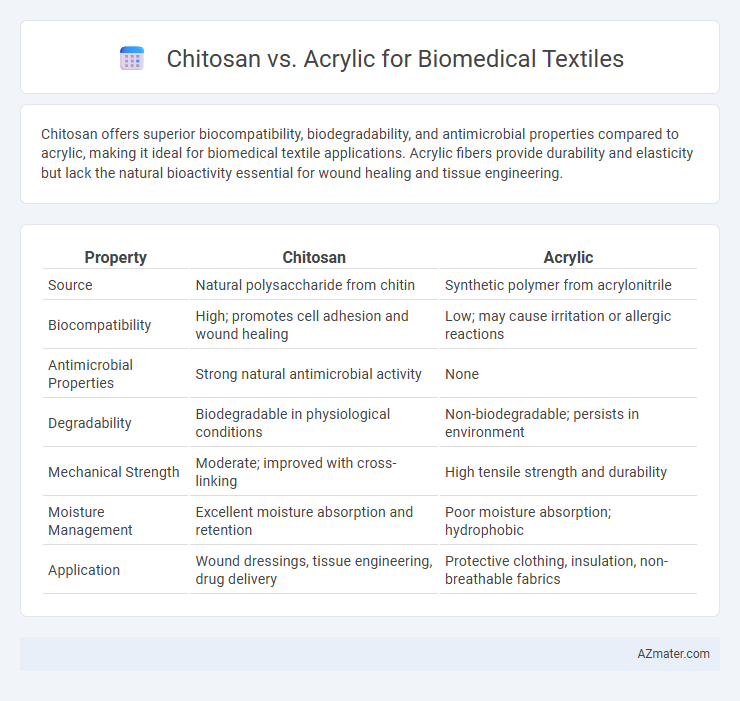Chitosan offers superior biocompatibility, biodegradability, and antimicrobial properties compared to acrylic, making it ideal for biomedical textile applications. Acrylic fibers provide durability and elasticity but lack the natural bioactivity essential for wound healing and tissue engineering.
Table of Comparison
| Property | Chitosan | Acrylic |
|---|---|---|
| Source | Natural polysaccharide from chitin | Synthetic polymer from acrylonitrile |
| Biocompatibility | High; promotes cell adhesion and wound healing | Low; may cause irritation or allergic reactions |
| Antimicrobial Properties | Strong natural antimicrobial activity | None |
| Degradability | Biodegradable in physiological conditions | Non-biodegradable; persists in environment |
| Mechanical Strength | Moderate; improved with cross-linking | High tensile strength and durability |
| Moisture Management | Excellent moisture absorption and retention | Poor moisture absorption; hydrophobic |
| Application | Wound dressings, tissue engineering, drug delivery | Protective clothing, insulation, non-breathable fabrics |
Introduction to Chitosan and Acrylic in Biomedical Textiles
Chitosan, a natural biopolymer derived from chitin, exhibits excellent biocompatibility, biodegradability, and antimicrobial properties, making it highly suitable for biomedical textile applications such as wound dressings and tissue engineering. Acrylic fibers, known for their durability, chemical resistance, and ease of manufacturing, are widely used in biomedical textiles for structural support and filtration purposes. The distinct characteristics of chitosan and acrylic influence their selection in biomedical textiles based on functional requirements like bioactivity and mechanical strength.
Chemical Structure and Properties Comparison
Chitosan, a natural polysaccharide derived from chitin, exhibits biocompatibility, biodegradability, and inherent antibacterial properties due to its amino and hydroxyl functional groups. Acrylic fibers, composed mainly of polyacrylonitrile with repeating acrylonitrile units, provide chemical stability, excellent durability, and hydrophobic characteristics but lack inherent bioactivity. The chemical structure of chitosan enables enhanced cell adhesion and wound healing applications, whereas acrylic's synthetic polymeric backbone offers mechanical strength and resistance to environmental degradation in biomedical textiles.
Biocompatibility and Safety for Medical Applications
Chitosan exhibits superior biocompatibility and biodegradability compared to acrylic fibers, making it highly suitable for biomedical textiles in wound dressings and tissue engineering. Its natural antimicrobial properties and ability to promote cell adhesion enhance safety and healing, whereas acrylic materials may induce inflammatory responses due to their synthetic, non-biodegradable nature. The integration of chitosan in medical textiles reduces cytotoxic risks and supports regulatory compliance for implantable and wearable healthcare devices.
Mechanical Strength and Durability Analysis
Chitosan-based biomedical textiles exhibit excellent biocompatibility and biodegradability but often face limitations in mechanical strength and long-term durability compared to acrylic fibers. Acrylic textiles demonstrate superior tensile strength and resistance to wear, making them more suitable for applications requiring sustained mechanical performance. Innovations in chitosan composite materials aim to enhance durability by integrating reinforcing agents to match or surpass the mechanical robustness of traditional acrylic biomedical textiles.
Antimicrobial Activity: Chitosan vs. Acrylic
Chitosan exhibits strong antimicrobial activity due to its polycationic nature, which disrupts microbial cell membranes, making it highly effective against a broad spectrum of bacteria and fungi in biomedical textiles. Acrylic fibers, in contrast, lack inherent antimicrobial properties and often require chemical treatments or incorporation of antimicrobial agents to achieve similar effects. Incorporating chitosan into biomedical textiles enhances biocompatibility and sustained antimicrobial efficacy, positioning it as a superior material for infection control in medical applications compared to acrylic.
Moisture Management and Breathability
Chitosan exhibits exceptional moisture management due to its natural hydrophilic properties, which enhance sweat absorption and promote rapid evaporation in biomedical textiles. In contrast, acrylic fibers, being synthetic, often retain moisture and provide less effective breathability, potentially causing discomfort in prolonged wear. The biocompatibility and antimicrobial features of chitosan further improve skin health by reducing microbial growth and maintaining optimal moisture balance in medical textile applications.
Biodegradability and Environmental Impact
Chitosan exhibits superior biodegradability compared to acrylic fibers, breaking down naturally through microbial activity in biomedical textiles and reducing long-term environmental pollution. Acrylic, derived from synthetic polymers, resists degradation and contributes to microplastic contamination in ecosystems when disposed of improperly. The use of chitosan enhances the sustainability of biomedical textiles by minimizing ecological footprint and promoting eco-friendly waste management practices.
Manufacturing Processes and Scalability
Chitosan-based biomedical textiles involve complex extraction from crustacean shells and require precise control during fiber spinning or coating to maintain bioactivity, posing scalability challenges. Acrylic fibers benefit from well-established synthetic polymer manufacturing methods such as free radical polymerization and melt spinning, enabling consistent mass production. The biocompatibility and biodegradability of chitosan compete with acrylic's ease of processing and industrial scalability, making the former more suitable for specialized biomedical applications despite lower large-scale manufacturing efficiency.
Cost Analysis and Market Availability
Chitosan offers a sustainable and biocompatible alternative to acrylic in biomedical textiles, with moderate raw material costs but higher processing expenses due to its natural extraction and purification methods. Acrylic, widely available and mass-produced, benefits from lower manufacturing costs and extensive market distribution, making it economically attractive for large-scale biomedical textile applications. Market availability favors acrylic for immediate supply, whereas chitosan is gaining traction driven by increasing demand for eco-friendly and antimicrobial textile solutions in healthcare.
Future Prospects and Innovations in Biomedical Textiles
Chitosan offers significant advantages in biomedical textiles due to its natural biocompatibility, biodegradability, and antimicrobial properties, making it ideal for wound dressings and tissue engineering applications. Acrylic fibers, while providing excellent mechanical strength and durability, face challenges in biodegradability and biocompatibility that limit their future use in advanced biomedical textiles. Innovations focus on blending chitosan with synthetic polymers or modifying acrylic fibers to enhance biofunctionality, aiming to create next-generation smart textiles with improved healing, drug delivery, and infection control capabilities.

Infographic: Chitosan vs Acrylic for Biomedical textile
 azmater.com
azmater.com